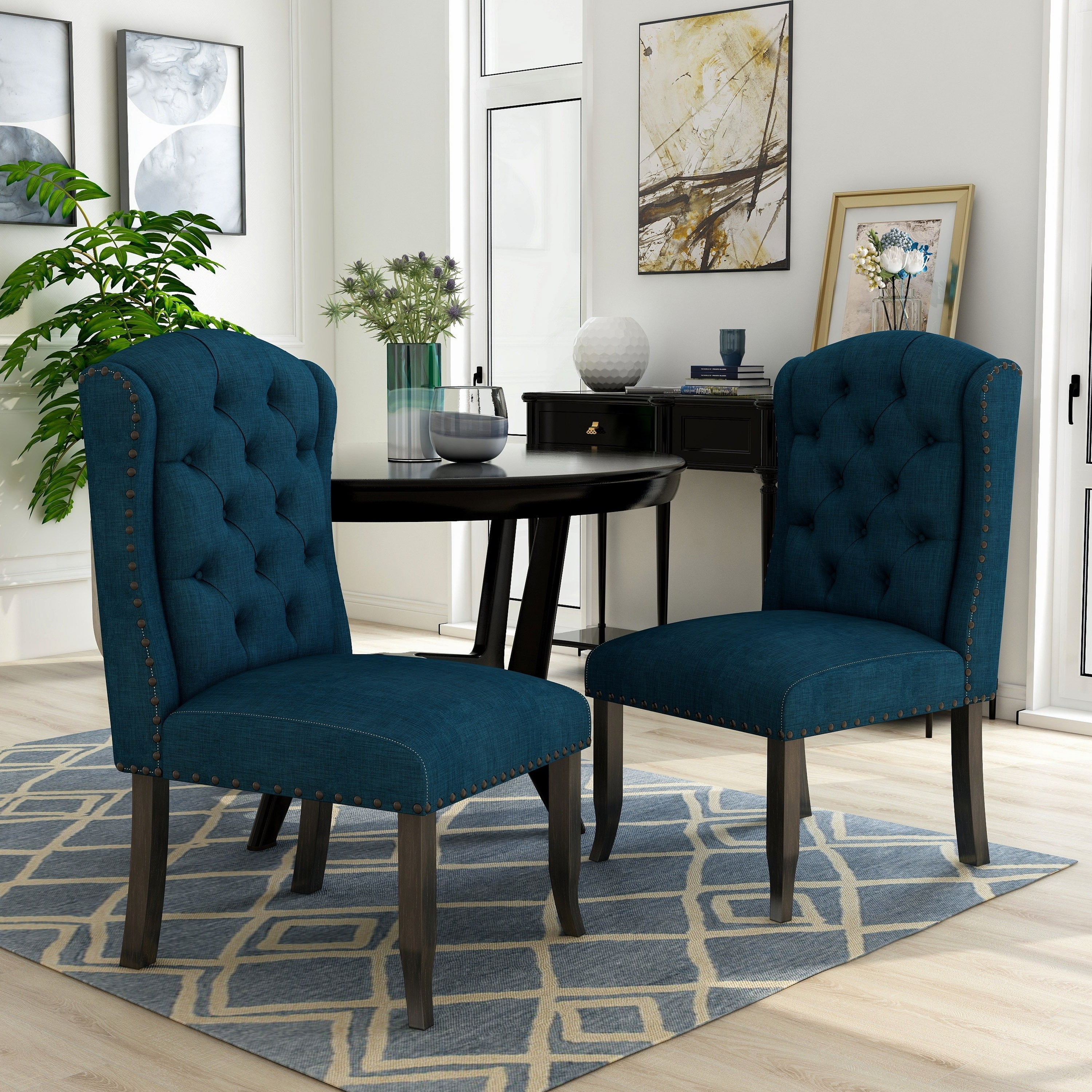Design & Aesthetics of Navy Wingback Dining Chairs

Navy wingback dining chairs offer a sophisticated blend of comfort and style, making them a popular choice for diverse interior designs. Their timeless appeal stems from a careful interplay of fabric, wood, and overall design philosophy, allowing for customization to suit various tastes and room aesthetics.
Fabric Choices and Their Impact
The fabric chosen significantly impacts the overall aesthetic. Velvet, for example, lends a luxurious and opulent feel, perfect for formal dining spaces. Linen offers a more relaxed, casual vibe, suitable for a farmhouse or coastal setting. Leather provides durability and a classic, sophisticated look, while bouclé adds texture and visual interest. The color navy itself provides a versatile backdrop, allowing the texture and sheen of the fabric to take center stage. Consider the light in your dining room; a plush velvet will absorb more light than a linen, influencing the overall ambiance.
Wood Finishes and Their Influence
The wood finish complements the fabric, influencing the chair’s overall style. Darker wood finishes, such as walnut or ebony, create a dramatic and formal look, pairing well with velvet or leather upholstery. Lighter finishes, like oak or maple, offer a brighter, more airy feel, better suited to linen or lighter fabrics. The type of wood also impacts the chair’s durability and longevity; hardwoods generally last longer than softwoods. A distressed finish can add a touch of rustic charm, while a polished finish exudes elegance.
Style Variations: Traditional, Modern, and Transitional
Navy wingback dining chairs come in various styles, each with distinct design features. Traditional styles often feature ornate carvings, curved lines, and high backs, embodying classic elegance. Modern designs, conversely, prioritize clean lines, minimalist aesthetics, and streamlined silhouettes, often featuring less ornamentation. Transitional styles bridge the gap between traditional and modern, blending classic elements with contemporary simplicity. The choice depends on the overall design scheme of the dining room.
Comparison of Navy Wingback Dining Chair Styles
| Style | Material | Notable Features | Price Range |
|---|---|---|---|
| Traditional | Velvet, Dark Wood (e.g., Walnut) | Ornate carvings, high back, curved arms, tufted upholstery | $300 – $1000+ |
| Modern | Linen, Light Wood (e.g., Oak), Metal | Clean lines, minimalist design, tapered legs, potentially upholstered in a simple fabric | $200 – $800+ |
| Transitional | Leather, Medium-toned Wood (e.g., Cherry) | Blends traditional and modern elements; may have subtle curves, but with a clean overall profile | $250 – $900+ |
Functionality & Practical Considerations

Navy wingback dining chairs offer a stylish addition to any dining room, but their functionality and practicality are equally important. Comfort, durability, and ease of maintenance all contribute to the overall value and longevity of these chairs. Let’s delve into the specifics.
Beyond their aesthetic appeal, the comfort and ergonomics of a navy wingback dining chair are crucial for enjoyable dining experiences. Factors such as back support, seat height, and overall seating experience directly impact user satisfaction.
Comfort and Ergonomics
The high back of a wingback chair provides excellent lumbar support, crucial for comfortable, prolonged sitting. The gently curved wings offer added side support, cradling the sitter and preventing fatigue. However, seat height is a key consideration; a chair that’s too high or too low can lead to discomfort. Ideally, the seat height should allow your feet to rest comfortably flat on the floor. A well-designed wingback chair will also have a seat cushion of appropriate depth and firmness, preventing pressure points and ensuring a pleasant seating experience.
Durability and Maintenance, Navy wingback dining chair
The durability of a navy wingback dining chair depends largely on the materials used in its construction. Solid wood frames are generally more durable than those made from cheaper materials like particleboard. The fabric upholstery plays a significant role too. High-quality fabrics, like linen or durable upholstery-grade cotton, will resist wear and tear better than cheaper options. Wood finishes should be robust and resistant to scratches and stains. Regular cleaning and maintenance are essential to prolong the lifespan of the chair.
Chair Care and Maintenance Guide
Proper care ensures your navy wingback dining chairs remain a beautiful and functional part of your home for years to come. Follow these steps for optimal maintenance:
Regular cleaning is key to preventing dirt and grime buildup, which can damage the fabric and wood over time.
- Dust Regularly: Use a soft cloth or brush to remove dust weekly. This prevents the accumulation of dirt that can eventually damage the fabric.
- Spot Clean Immediately: Address spills and stains immediately. Blot (don’t rub!) spills with a clean cloth to prevent them from setting into the fabric. For specific stain removal, consult the upholstery fabric care instructions.
- Vacuum Periodically: Use the upholstery attachment of your vacuum cleaner to gently remove embedded dirt and dust from the fabric. Avoid using excessive suction.
- Protect from Direct Sunlight: Prolonged exposure to direct sunlight can fade the fabric and damage the wood finish. Consider using curtains or blinds to minimize exposure.
- Condition Wood Regularly: For wood frames, apply a suitable wood conditioner or polish every few months to maintain its luster and protect it from dryness and cracking. Follow the product instructions carefully.
- Avoid Harsh Chemicals: Never use harsh chemicals or abrasive cleaners on the fabric or wood. These can damage the materials and void any warranties.
